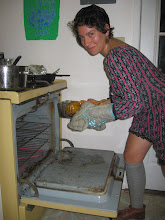Alright patient food blog fans. I’m sorry that I have abandoned you for months on end with no posts. I’m going to start catching you up with my latest projects, things you could do right now with the present season’s available ingredients, and gradually work my way back through the last four or five months.
Summertime in Louisville
For the last month I’ve been hangin out at my parents’ house in Louisville, KY. When I haven’t been biking back and forth across town to see friends, I’ve mostly been occupying myself going to different farmers’ markets, canning, cooking, and rescuing random languishing vegetables from my parents’ fridge.
Exhibit A:

Sad cabbage.
The purple one was actually quite happy, as I had just purchased it from a farmer, but God only knows how long that yellow one had been aging in the crisper. It still felt firm though, so with outer leaves discarded, it was time to make a batch of sauerkraut!
This was actually the first batch of cabbage kraut that I’d ever made; my prior kraut-making had been exclusively with beets and turned out way too salty, but ended up making an excellent base for borscht. Driving out to Detroit with Olympia friends at the beginning of this summer, Taiga brought along a jar of OlyKraut’s (local kraut-making business) curried kraut and it was the most addictive kraut I have ever had the pleasure of eating. Gingery, garlicky, curry-y, and spicy, it was yellow and delectable and I instantly knew that I was going to have to make some later.
While my mom keeps a well-stocked spice cabinet, one of my personal household staples in Olympia, gingerroot, was notably not available. I knew going in it was going to be a flavor compromise to use powdered ginger in its stead, but sometimes it’s just not worth the grocery store run, y’know? Kraut is really quite simple to make and after the recipe instructions for the beet kraut let me down and oversalted me, this time was by feel. If you have kraut ambitions of your own, your first batch may well turn out saltier than you want if you use some of the more commonly recommended salt measurements, but it’s all to taste, so play around and see what you like. This batch turned out delicious, more robust and bodied than the OlyKraut inspiration due to the purple cabbage (the original had been all green), but I like it. Next time I will definitely use fresh ginger and chop up the garlic to get more zing per bite, but I like the way the flavors melded together using all powdered spices and it’s the perfect amount of tart.
Here’s what I did. I don’t have any measurements for you, I just shook stuff in, but if you cook a lot and know what you like, this is a great food for trusting your instincts and forgoing the measuring spoons.
- Peeled the outer leaves off two medium-sized cabbages and chopped them coarsely (fineness of cabbage is totally a preference thing. I like the rough and tumbleness of what I got, but I think I’ll go finer for my next batch).
- Mixed cabbage with about a teaspoon of salt in a large bowl. Shook in curry powder, ginger, turmeric and cayenne pepper to taste and stirred well. Threw in about a dozen whole garlic cloves.
- Transferred mixture to a ceramic crock (I actually used a crock pot, but you can use jars or anything that you can pack the cabbage down into. Bowls aren’t ideal because of the way most taper, but if that’s what you got I imagine they would still work). Pushed the cabbage down with my fists until natural brine from the cabbage and salt formed and rose above the surface of the cabbage.


- Weighted the cabbage down using an enormous (probably over a gallon) bottle of Heinz vinegar that I stuck inside of a gallon Ziploc bag to cover the bottom. The Ziploc bag was really just because I didn’t trust the cleanliness of the bottom of the bottle, but the point is to weigh your kraut down so that the brine remains above the cabbage. People use all sorts of different things for weights including Ziploc bags filled with brine. As long as your weight is big enough to cover the top surface area of your kraut, you’re good; a little smaller is ok, but for instance I wouldn’t want to use a quart mason jar as the weight for this batch because it would be too small.
- Draped the vinegar bottle and rim of the crock with two thin cloths to keep out bugs and dust. Set the crock in a shady spot of our dining room. Left it to ferment!
- Checked every few days to make sure the brine level was still above the kraut and started tasting the kraut after about a week.
- After one month, the kraut was tasting good and tart. While I would probably have let it keep going longer, I figured with two weeks left in town I needed to start eating it now so I didn’t leave behind a huge jar that my family probably wouldn’t be as enthusiastic about as me… haha. Packed the kraut into one quart and one pint mason jar, pushing down to make the brine rise again before storing in the fridge.


Juicy!
P.S. Don’t forget: Fermented foods like sauerkraut are probiotics (supporting life and healthy immune system-boosting microorganisms in your body) and are supremely good for your digestion. Eat fermented foods with every meal! For more info, I highly recommend Wild Fermentation by Sandor Ellix Katz.

No comments:
Post a Comment